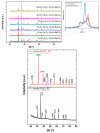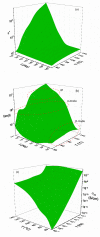Multitasking Performance of Fe3O4/BaTiO3/Epoxy Resin Hybrid Nanocomposites
- PMID: 35269016
- PMCID: PMC8911469
- DOI: 10.3390/ma15051784
Multitasking Performance of Fe3O4/BaTiO3/Epoxy Resin Hybrid Nanocomposites
Abstract
In this study, hybrid nanocomposites consisting of Fe3O4/BaTiO3/epoxy resin were prepared with varying amounts of filer content. Structural and morphological characterization, conducted via X-Ray Diffraction patterns and Scanning Electron Microscopy images, revealed the successful fabrication of composites and fine dispersion of inclusions. Thermomechanical properties are studied via Differential Scanning Calorimetry, Thermogravimetric Analysis, Dynamic Mechanical Analysis and static mechanical tests. Hybrid composites exhibit enhanced thermal stability and improved mechanical response. Indicatively, Young's modulus, tensile strength and fracture toughness increase from 1.26 GPa, 22.25 MPa, and 3.03 kJ/m3 for the neat epoxy to 1.39 GPa, 45.73 MPa, and 41.08 kJ/m3 for the composites with 20 or 15 parts per hundred resin per mass (phr) of Fe3O4, respectively. Electrical behavior is investigated via Broadband Dielectric Spectroscopy and ac conductivity measurements. The real part of dielectric permittivity reaches the value of 11.11 at 30 °C for the composite with 40 phr of Fe3O4. The ability to store and retrieve electric energy on the nanocomposites is examined with the following parameters: the filler content and the applied voltage under dc conditions. Retrieved energy reaches 79.23% of the stored one, for the system with 15 phr of Fe3O4. Magnetic response is studied via a Vibrating Sample Magnetometer. Magnetic saturation, for the system with the highest magnetic filler content, obtains the value of 25.38 Am2/kg, while pure magnetic powder attains the value of 86.75 Am2/kg. Finally, the multifunctional performance of the nanocomposites is assessed regarding all the exerted stimuli and the optimum behavior is discussed.
Keywords: electrical properties; energy storing/retrieving; hybrid nanocomposites; magnetic response; multifunctionality; thermomechanical behavior.
Conflict of interest statement
The authors declare no conflict of interest.
Figures










References
-
- Song K., Guo J.Z., Liu C. Polymer-Based Multifunctional Nanocomposites and Their Applications. Elsevier; Amsterdam, The Netherlands: 2019.
-
- Friedrich K. Routes for achieving multifunctionality in reinforced polymers and composite structures. In: Friedrich K., Breuer U., editors. Multifunctionality of Polymer Composites. Elsevier; Amsterdam, The Netherlands: 2015. pp. 3–41.
-
- Krawczak P. Polymer composites: Evolve towards multifunctionality or perish. eXPRESS Polym. Lett. 2019;13:771. doi: 10.3144/expresspolymlett.2019.65. - DOI
-
- Psarras G.C. Ceramic/Polymer Nanodielectrics: Towards A Multifunctional OR Smart Performance; Proceedings of the ECCM18—18th European Conference on Composite Materials; Athens, Greece. 24–28 June 2018; pp. 24–28.
-
- Psarras G.C. Smart polymer systems: A journey from imagination to applications. eXPRESS Polym. Lett. 2011;5:1027. doi: 10.3144/expresspolymlett.2011.100. - DOI
Grants and funding
LinkOut - more resources
Full Text Sources

